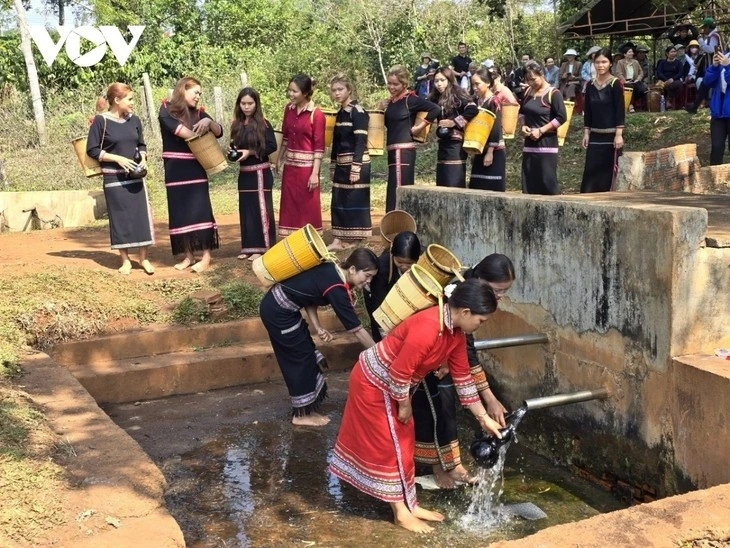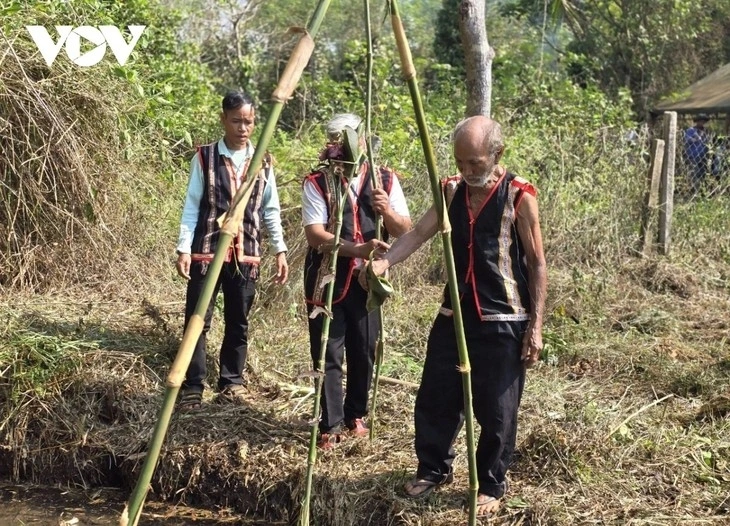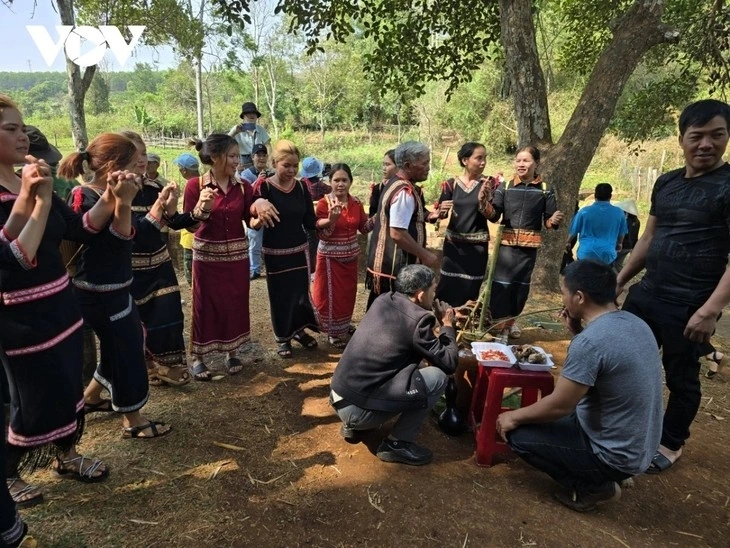
Jrai’s rain praying ceremony showcases harmony of people, nature, and faith
Cập nhật: 06/10/2025
![]() HIEUTHUHAI trình diễn 45 phút tại lễ hội âm nhạc Mbillion
HIEUTHUHAI trình diễn 45 phút tại lễ hội âm nhạc Mbillion
![]() Đen Vâu nắm tay Hoàng Thùy Linh trong concert tôn vinh vùng mỏ Quảng Ninh
Đen Vâu nắm tay Hoàng Thùy Linh trong concert tôn vinh vùng mỏ Quảng Ninh
VOV.VN - The rain praying ceremony is a spiritual and cultural activity, representing the distinctive identity of the Jrai ethnic group in Gia Lai province. The Jrai people have preserved the ritual’s original traditional values, enriching the cultural heritage of ethnic Central Highlanders.

Held annually in April or May, the Yang Potao Apui (rain praying ceremony) in Chu A Thai commune has been cherished and preserved by the Jrai people for generations. The commune, which lies in Gia Lai’s largest rice granary area, is closely associated with legends of the Fire King and Water King.
From early morning, almost all villagers gathered at the foot of the sacred Chu Tao Yang Mountain for the rain praying ceremony. An excited atmosphere filled the location with people - young and old, men and women - all who had donned their colorful traditional costumes. The village’s council, made up of respected male elders, decorated the Neu bamboo tree and prepared offerings to present to the deities.
“It is a great honor to participate in the ceremony. Our wish is to revive the traditions and identity of the Jrai people,” said Rmah Phiet.
Before the main ritual, the villagers perform three smaller rituals: expelling evil spirits and diseases, worshiping the water source at the A Yun river, and honoring the village tutelary.
Women cook while young men go to the forest to cut bamboo plants, catch snails and fish, as well as help the elders with the heavier tasks for the ritual.

Once the preparation is completed, the main ritual will be presided over by the village elders’ council, consisting of those who have not violated village taboos and who have had a positive influence on the community.
On the day of the ceremony, the villagers must observe taboos: not working and not holding farm tools such as hoes or knives. The main offerings include three jars of Jobo liquor and a black male pig without white spots on its skin, weighing about 20kg. Ritual utensils consist of a bronze bowl, five white porcelain bowls, and five bamboo straws, which are kept solely for rituals and not used on ordinary days.
At around 9 a.m., the rain praying ritual begins. The celebrant calmly walks to sit before the three jars of liquor. Placing his hand on the first jar, he recites a prayer in the Jrai language, expressing the wish for favorable weather, peace, health, and prosperity for the villagers.
The prayer lasts about 10 minutes, after which he pours fresh water from the bronze bowl into the jars, then drinks a sip through the straw. The villagers then take turns enjoying the liquor.
“We pray for rain and health for all people. Favorable weather conditions will help guarantee a good life for the people,” said Siu Pho, who chairs the Yang Potao Apui rain praying ritual.

The Jrai believe that humans were born together with all creatures and beings. Deities are prayed for granting life and protecting humans. The Water God gives life. The Rain God brings fertility to plants and crops. And the Wind God and Fire God guard the sacred flame.
“Every year it’s the same: once the ritual is done, rain falls immediately. With rain, life will prosper,” Siu Kur, a resident of Chu A Thai commune, said.
In Jrai legends, there were 14 generations of kings, called “Potao Apui” which means the Fire Kings, who had the power to call uponthe rain and wind, helping the villagers overcome droughts.
Stories about the 14 generations of Fire Kings over the last 5 centuries and their sacred sword with the power to summon rain and wind have been passed down with utmost reverence in Plei Oi region. The last chosen king was Mr. Siu Luynh, the 14th Fire King, but he passed away in 1999 before receiving the sword, so he was not called Pơtao.
Since then, there has been no successor and the customs have ended. His tomb is placed in the cemetery of the Fire Kings at Cheo Reo valley, now the Plei Oi relic site in Chu A Thai commune. Nowadays, the rain praying rituals are performed by the assistants.
“Water and farm tools are essential for rice farmers in the Central Highlands. For the Jrai, the Potao Apui ceremony is a sacred way of sending their aspirations to the heavens, embodying a culture inseparably linked with nature,” said Associate Professor Dr. Nguyen Khac Su, former researcher at the Institute of Archaeology.
The Yang Potao Apui rain praying ceremony, a cultural symbol of the Central Highlands, has been recognized as a national intangible cultural heritage.
![]() Từ khóa: Jrai, Jrai, rain praying ceremony, ethnic group, Gia Lai, Central Highlanders
Từ khóa: Jrai, Jrai, rain praying ceremony, ethnic group, Gia Lai, Central Highlanders
![]() Thể loại: Văn hóa - Giải trí
Thể loại: Văn hóa - Giải trí
![]() Tác giả: vov5
Tác giả: vov5
![]() Nguồn tin: VOVVN
Nguồn tin: VOVVN